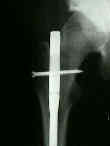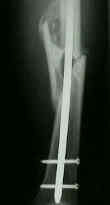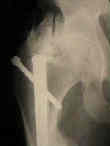- See: Comminuted Femoral Shaft Fractures
- Complications:
- compartment syndrome of thigh
- femoral IM nail infection
- avascular necrosis from IM nailing
- femoral non union
- Implant failures:
- associated w/ either the insertion of a small diameter nail or use of an interlocking nail for a very prox. or distal shaft frx;
- plastic deformation (bending) of the IM rod mainly occurs w/ nails that are less than 10 mm in diameter;
- minimal nail diamters range 12-14 mm for women & 13-15 mm for men;
- failures w/ interlocking nails: tendency to use smaller diamter nails (nail may fail at hole site);
- weak part of the nail is proximal of the 2 distal holes;
- frx located w/ in 5 cm of this hole will be stressed above endurance limit w/ ambulation;
- these frx must have delayed wt bearing until callus is present;
- early dynamization, esp of subisthmal fractures, is associatted w/ increased risk of developing a valgus deformity at the fx site;
- bending of the nail at the fracture site usually occurs as an early complication caused by premature wt bearing, lack of adequate support, or deficient material (nail) strength;
- bent distal screws may result from early wt bearing if the screws are too close to the fracture site;
- nail removal:
- if inner diameter of nail is threaded, use a cone shaped universal extractor in order to lock on to the nail, allowing its removal;
- or use a metal cutting carbide tip to create a hole in the nail, which then allows an extracting device to be inserted;
- reference: Broken intramedullary nails.

- Shortening:
- often due to dyanamic interlocking w/ excessive post op wt bearing;
- management of limb length inequality:
- descrepancy < 1.2 cm: does not require intervention except for contra-lateral show lift;
- descrepancy between 1.2 - 2.5 cm;
- this is the grey zone, and treatment is controversial;
- patients will often compensate for the leg length inequality thru increased flexion and circumduction of the long extremity and through toe walking of the short limb;
 - descrepancy > 2.5 cm;
- descrepancy > 2.5 cm;
- most agree that all discrepancies projected to be > 2.5 need treatment;
- limb lengthening:
- only indicated for severe deformities in relatively short adults;
- limb shortening:
- closed femoral shortening is often the treatment of choice;
- references:
- Closed shortening of the femur
- Closed intramedullary osteotomies of the femur.
- Malunion:
- malrotation of more than 10 deg
- varus or valgus angulation more than 7 deg
- AP angulation more than 10 deg
- leg shortening of more than 1.5 cm;
- high rate (11%) of valgus deformity produces w/ lateral position;
- when a nail is loose, the solution is less definite;
- references:
- The Clamshell Osteotomy: a New Technique to Correct Complex Diaphyseal Malunions
- Osteotomy planning using the anatomic method: a simple method for lower extremity deformity analysis.
- Hetertopic Ossification:
- may be more common w/ head injury;
- references:
- Heterotopic ossification about the hip after intramedullary nailing for fractures of the femur.
- Heterotopic ossification around the hip with intramedullary nailing of the femur.
- Misc Complications:
- irritation of soft tissues over the heads of the proximal transfixing screws has occurred in 7% of cases;
- this may lead to the formation of an adventitious bursa over the screw heads or snapping of the iliotibial band;
- removal of the proximal screws usually alleviates the problem
Closed interlocking nailing of femoral shaft fractures: assessment of technical complications and functional outcomes by comparison of a prospective database with retrospective review.
Pitfalls, errors, and complications in the use of locking Küntscher nails.

